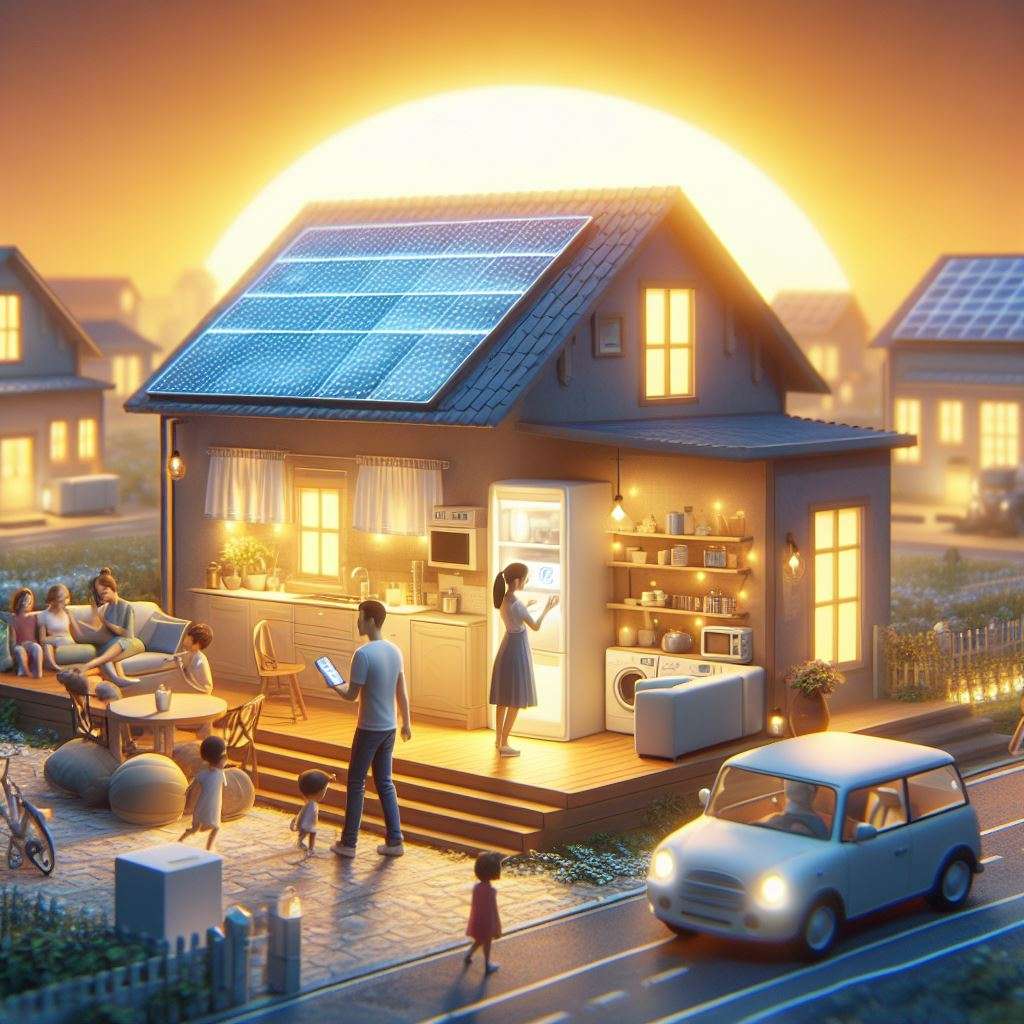Have you ever felt frustrated by your high energy bills or worried about the environmental impact of your electricity consumption? Do you wish you could take control of your energy production and reduce your dependence on the grid? If so, you might want to consider installing solar panels on your home.

Solar panels are devices that capture the sun’s energy and convert it into electricity that you can use to power your appliances, lights, and gadgets. By installing solar panels on your roof, you can generate your own renewable energy and enjoy a range of benefits, from saving money to saving the planet.
In this article, we will explain how solar panels work, what types are available, and how they can benefit you and your home. We will also guide you through the process of installing solar panels and address some common questions and concerns.
Finally, we will show you some examples of how solar panels have transformed the lives of people and communities around the world.
Unleashing the Sun’s Potential: How Solar Panels Work
The sun is the ultimate source of energy for our planet. It provides us with light, heat, and life. But did you know that it can also provide us with electricity?
Solar panels are made of small units called photovoltaic cells, which are usually made of silicon. These cells act like tiny factories that turn sunlight into electricity. When sunlight hits a cell, it knocks electrons loose from the silicon atoms. These electrons flow through a circuit and create an electric current. This current is then sent to an inverter, which converts it from direct current (DC) to alternating current (AC), which is the type of electricity we use in our homes.
The amount of electricity a solar panel can produce depends on several factors, such as the size, efficiency, and orientation of the panel, the amount and angle of sunlight, and the weather conditions. Generally, the more sunlight a panel receives, the more electricity it can generate.
There are different types of solar panels, each with its advantages and disadvantages. The most common ones are:
- Monocrystalline solar panels: These are made of single-crystal silicon cells, which have a uniform dark color and a high efficiency of up to 22%. They are also more durable and perform better in low-light conditions. However, they are also more expensive and require more space than other types of panels.
- Polycrystalline solar panels: These are made of multiple-crystal silicon cells, which have a bluish hue and a lower efficiency of up to 18%. They are cheaper and easier to produce than monocrystalline panels, but they also degrade faster and perform worse in high temperatures and low-light conditions.
- Thin-film solar panels: These are made of thin layers of materials such as amorphous silicon, cadmium telluride, or copper indium gallium selenide, which are deposited on a substrate such as glass, metal, or plastic. They have a flexible and lightweight design and a low cost of production. However, they also have a low efficiency of up to 11% and require a lot of space and maintenance.
Shine On You Crazy Diamond: Benefits Bright and Bold
Installing solar panels in your home can bring you a host of benefits, both for your wallet and for the world. Here are some of the most compelling ones:
- Reduced energy bills: By generating your electricity, you can reduce or even eliminate your reliance on the grid and save money on your monthly bills. Depending on your location, system size, and energy usage, you can save anywhere from 10% to 75% on your electricity costs. You can also earn money by selling your excess electricity back to the grid or to other consumers through a scheme called net metering or feed-in tariff.
- Increased property value: By adding solar panels to your home, you can increase its value and attractiveness to potential buyers. According to a study by the Lawrence Berkeley National Laboratory, solar homes sell for 4.1% more than non-solar homes on average. Solar panels can also extend the lifespan of your roof by protecting it from weather damage and reducing heat loss.
- Independence from the grid: By producing your own electricity, you can reduce your dependence on the grid and avoid power outages, price fluctuations, and supply issues. You can also store your excess electricity in batteries or backup generators and use it when the sun is not shining or when the grid is down. This way, you can enjoy uninterrupted power and peace of mind.
- Positive impact on the environment: By switching to solar energy, you can reduce your carbon footprint and help fight climate change. Solar panels do not emit any greenhouse gases or pollutants, unlike fossil fuels, which are the main contributors to global warming. According to the U.S. Environmental Protection Agency, the average American household emits 14,920 pounds of carbon dioxide per year from electricity use. By installing a 5-kilowatt solar system, you can prevent 7,000 pounds of carbon dioxide from entering the atmosphere each year, which is equivalent to planting 88 trees or driving 8,000 miles less.
From Rooftop to Reality: Making Solar Your Own
If you are interested in installing solar panels on your home, you might be wondering how to go about it. Here are some practical steps to follow:

- Find reputable installers: The first step is to find a qualified and trustworthy solar installer who can assess your home, design your system, and install your panels. You can use online platforms such as SolarReviews, EnergySage, or Pick My Solar to compare quotes, reviews, and ratings from different installers in your area. You can also ask for referrals from friends, family, or neighbors who have gone solar.
- Obtain permits: The next step is to obtain the necessary permits and approvals from your local authorities, utility company, and homeowners association. Your installer can help you with this process, which may vary depending on your location, system size, and interconnection type. Generally, you will need to apply for a building permit, an electrical permit, and a solar permit, as well as pass inspections and sign agreements with your utility company and homeowners’ association.
- Navigate financing options: The final step is to choose a financing option that suits your budget and preferences. There are three main ways to pay for your solar system: cash, loan, or lease. Each option has its own pros and cons, which you can explore in detail here. Cash is the simplest and cheapest option, but it requires a large upfront investment. Loan is the most common and flexible option, but it involves interest and fees. Lease is the easiest and fastest option, but it limits your ownership and savings.
You might have some questions or concerns about installing solar panels on your home, such as:
- How much does it cost? The cost of installing solar panels depends on several factors, such as the size, type, and quality of your system, the location and condition of your roof, the incentives and rebates available in your area, and the installer you choose. According to the Solar Energy Industries Association, the average cost of a residential solar system in the U.S. was $2.81 per watt in 2020, which translates to $14,050 for a 5-kilowatt system before incentives. However, this cost can vary widely depending on your specific situation and can be reduced significantly by applying for federal, state, and local incentives and rebates, which can cover up to 50% of your system cost.
- Is my roof suitable?: The suitability of your roof for solar panels depends on its size, shape, orientation, slope, material, and age. Generally, the ideal roof for solar panels is large, flat, south-facing, and made of durable materials such as asphalt, metal, or tile. However, solar panels can also work on roofs that are smaller, curved, east- or west-facing, and made of other materials such as wood, slate, or rubber. The only roofs that are not suitable for solar panels are those that are too old, damaged, or shaded by trees, buildings, or other obstacles. Your installer can evaluate your roof and recommend the best solution for your situation.
- What are the potential challenges?: Installing solar panels on your home can pose some challenges, such as finding a reliable installer, obtaining permits and approvals, dealing with weather and maintenance issues, and facing opposition from your utility company or homeowners association. However, these challenges can be overcome with proper research, planning, and communication. You can also consult with experts, advocates, and peers who can guide you through the process and help you resolve any problems.
Join the Solar Revolution: Light Up Your World
Installing solar panels on your home is not only a smart financial decision but also a meaningful social and environmental one. By going solar, you can join a growing community of people and organizations who are committed to a cleaner, greener, and brighter future.
Further Reading
- Energy-efficient appliances: Look for Energy Star certified appliances to save energy and reduce your carbon footprint.
- Refill stations: Buy essential cleaning products like detergents and soaps in bulk at refill stations to reduce bottle waste
- Solar Energy vs. Fossil Fuels: Pros and Cons Comparison
- Renewable and solar energy vs fossil fuels
